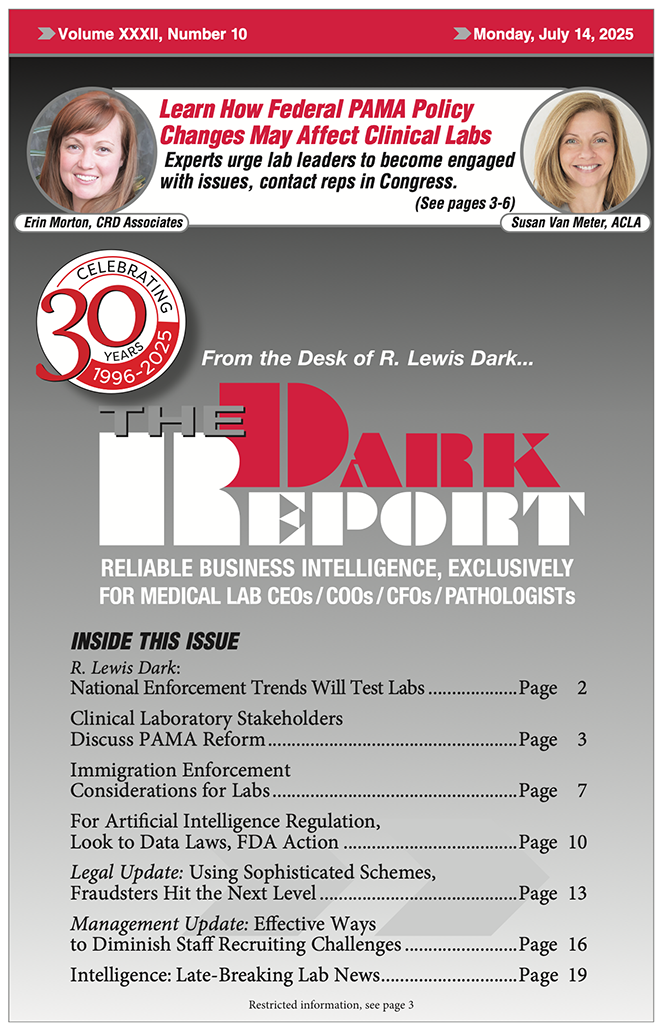Laboratory Management
Laboratory management in today’s clinical lab industry is changing rapidly and facing entirely new challenges. One problem is the lack of upcoming younger lab managers, as the retirements of baby boomer pathologists, medical technologists and lab scientists are in the near future. These individuals make up the largest proportion of supervisors, managers, and lab administrators working in labs today.
As they retire, every clinical lab and pathology group needs to have the next generation of leaders ready to step up and assume responsibilities. But, across the lab industry, there are limited opportunities for every lab’s brightest up-and-comers to get the regular management development opportunities that are common among Fortune 500 companies. The Dark Intelligence Group has called for the establishment of a mentoring program to help overcome this problem.
At the same time, downward pressure on reimbursements and mounting competition have created an environment that requires much more effort for a medical lab to grow and thrive.
Legislation, including the Health Information Technology for Economic and Clinical Health Act (HITECH) of 2009 and the Patient Protection and Affordable Care Act (PPACA) of 2010, have placed significant demands on medical laboratories and healthcare providers to improve internal efficiency even while offering more services for less money. This pressure to “do more with less” is further compounded by the need to deliver increasingly personalized client service to retain and win clients.
With the era of fee-for-service medicine coming to a close, every clinical laboratory and anatomic pathology organization needs a strategy for getting paid, as new reimbursement models that support patient-centric care will make up a larger portion of lab revenues.
The challenge for every clinical laboratory manager is to understand how to evolve from a business model that is accession-centric or volume-centric to one that is patient-centric.
Many clinical laboratories today are developing data repositories to logically link all transactional and other information about a patient. These repositories allow physicians to see all relevant information, identify trends, and provide better care as a result, enabling labs to provide greater value to their customers, patients and payers, thus creating more value and becoming more patient-centric.
ISO 15189 Accreditation Program Offered by CAP
By Robert Michel | From the Volume XXVI No. 12 – September 3, 2019 Issue
CEO SUMMARY: Two strong trends in laboratory management can be seen in the College of American Pathologists’ (CAP) move to offer accreditation to ISO 15189:2007. The first trend is the movement toward quality management systems such as Lean and Six Sigma. The second trend is the global …
UK Laboratories Pushed to Serve Primary Care
By Robert Michel | From the Volume XXVI No. 12 – September 3, 2019 Issue
CEO SUMMARY: At the fifth annual Frontiers in Laboratory Medicine (FiLM) meeting in Birmingham, England, lab administrators and pathologists from the United Kingdom and the United States gathered to share knowledge about innovations in the management of clinical laboratories. The event so…
AmeriPath Will Acquire Specialty Laboratories
By Robert Michel | From the Volume XXVI No. 12 – September 3, 2019 Issue
CEO SUMMARY: It’s a surprise to most lab industry observers. AmeriPath, a company built around 400 anatomic pathologists working mostly in community hospitals, is acquiring a national reference/esoteric testing company. However, this deal may be better understood by looking at the motiv…
Bio-Reference Labs Develops Regional & Niche Strategies
By Robert Michel | From the Volume XXVI No. 12 – September 3, 2019 Issue
CEO SUMMARY: Bio-Reference Laboratories, Inc. (BRLI) of Elmwood Park, New Jersey is a lab company on a roll. In just five years, it has grown from $66 million to more than $160 million in annual revenues. For regional laboratories across the country, BRLI’s business strategies demon…
Profit Squeeze Pressures Specialty Laboratories
By Robert Michel | From the Volume XXVI No. 12 – September 3, 2019 Issue
CEO SUMMARY: Despite much success and milestones at Specialty Laboratories during the past 36 months, it has yet to achieve the most important goal of all: net profits. One reason is familiar to all laboratory administrators and pathologists: with its existing fixed overhead and cost stru…
Homocysteine Patent Triggers Royalty Demand
By Robert Michel | From the Volume XXVI No. 12 – September 3, 2019 Issue
CEO SUMMARY: Laboratory Corporation of America fought a patent infringement case against the holder of the homocysteine assay patent and lost after a five-year court battle. Now Competitive Technologies, Inc. (CTI), armed with its victory in federal court, is ready to negotiate royalty ar…
Florida Labs Face Off With Hurricane Charley
By Robert Michel | From the Volume XXVI No. 12 – September 3, 2019 Issue
CEO SUMMARY: Hurricane Charley not only validated long-standing laboratory emergency contingency plans, but it introduced new issues. Even two weeks after the hurricane, hospital labs in the most affected communities continue to deal with storm-related problems. One issue is that damaged …
Leonard Joins AEL’s Board, Cenetron Is Newest Acquisition
By Robert Michel | From the Volume XXVI No. 12 – September 3, 2019 Issue
There were two big announcements at American Esoteric Laboratories, Inc. (AEL) during the past few weeks. First came news on July 20 that Larry L. Leonard was now on the Board of Directors at AEL. Leonard had been part of the senior executive team at Laboratory Corporation o…
LabOne in Cincinnati: Watch Events Unfold
By Robert Michel | From the Volume XXVI No. 12 – September 3, 2019 Issue
CEO SUMMARY: It’s another example of a commercial laboratory taking over the laboratory assets of a multi-hospital consolidated laboratory. Will LabOne manage these assets and get more growth, more cost savings, and more profit? If this happens, it will mark the third time in r…
Spectrum Lab Network Expands Into Tennessee
By Robert Michel | From the Volume XXVI No. 12 – September 3, 2019 Issue
CEO SUMMARY: During the past four years, this energized hospital laboratory joint venture has posted significant growth in its laboratory outreach program. One notable accomplishment has been the effective deployment and use of Web browser-based lab test orders and results reporting with …
CURRENT ISSUE

Volume XXXII, No. 10 – July 14, 2025
This issue is strong on different flavors of enforcement that clinical laboratories, whether they want to or not, will need to contend with. Lab stakeholders provide insights that medical labs need to brace for more action to counter pending test reimbursement rate cuts under PAMA. Also, this issue provides the legal and regulatory landscape for clinical labs’ use of AI and how it evolves with the technology. AI is creating legal uncertainty for clinical labs, especially around data privacy and FDA oversight of AI tools in diagnostics.
See the full table of contentsHow Much Laboratory Business Intelligence Have You Missed?
Lab leaders rely on THE DARK REPORT for actionable intelligence on important developments in the business of laboratory testing. Maximize the money you make-and the money you keep! Best of all, it is released every three weeks!
Sign up for TDR Insider
Join the Dark Intelligence Group FREE and get TDR Insider FREE!
Never miss a single update on the issues that matter to you and your business.
Topics
- Anatomic Pathology
- Clinical Chemistry
- Clinical Laboratory
- Clinical Laboratory Trends
- Digital Pathology
- Genetic Testing
- In Vitro Diagnostics
- IVD/Lab Informatics
- Lab Intelligence
- Lab Marketplace
- Lab Risk & Compliance
- Laboratory Automation
- Laboratory Billing
- Laboratory Compliance
- Laboratory Equipment
- Laboratory Information Systems
- Laboratory Management
- Lean Six Sigma
- Managed Care Contracts
- Molecular Diagnostics
- Pathology Trends
- People
- Uncategorized

